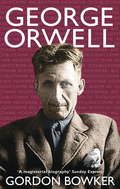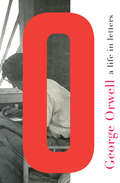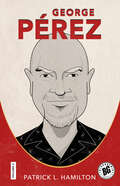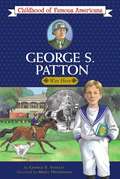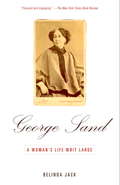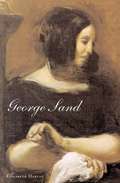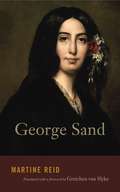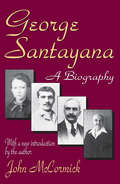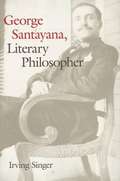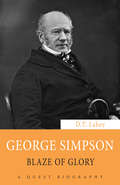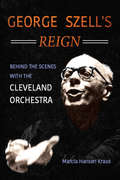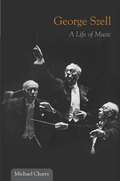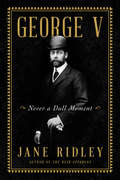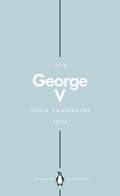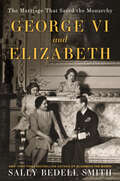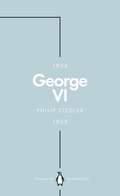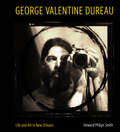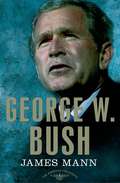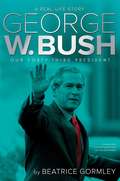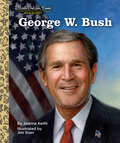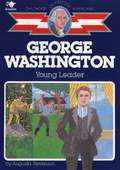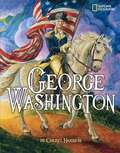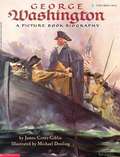- Table View
- List View
George Orwell
by Gordon Bowker'Adds enormously to our understanding of the man' Evening StandardGeorge Orwell was one of the greatest writers England produced in the last century. He left an enduring mark on our language and culture, with concepts such as 'Big Brother' and 'Room 101.' His reputation rests not only on his political shrewdness and his sharp satires (Animal Farm and Nineteen Eighty-Four) but also on his marvellously clear style and superb essays, which rank with the best ever written. Gordon Bowker's new biography includes fascinating new material which brings Orwell'slife into unfamiliar focus. He writes revealingly about Orwell's family background; the lasting influence of Eton on his work and character; his superstitious streak and youthful flirtation with black magic; and his chaotic and reckless sex life, which included at least one homoerotic relationship. It highlights the strange circumstances of his first marriage and provides remarkable new evidence of his experiences in Spain and their nightmarish consequences. It also offers a fresh look at his peculiar deathbed marriage to a woman fifteen years his junior. All this has enabled Bowker to give Orwell's life a brilliantly fresh and distinctive interpretation.
George Orwell: A Life in Letters
by George Orwell Peter DavisonAppearing for the first time in one volume, these trenchant letters tell the eloquent narrative of Orwell's life in his own words. From his school days to his tragic early death, George Orwell, who never wrote an autobiography, chronicled the dramatic events of his turbulent life in a profusion of powerful letters. Indeed, one of the twentieth century's most revered icons was a lively, prolific correspondent who developed in rich, nuanced dispatches the ideas that would influence generations of writers and intellectuals. This historic work--never before published in America and featuring many previously unseen letters--presents an account of Orwell's interior life as personal and absorbing as readers may ever see. Over the course of a lifetime, Orwell corresponded with hundreds of people, including many distinguished political and artistic figures. Witty, personal, and profound, the letters tell the story of Orwell's passionate first love that ended in devastation and explains how young Eric Arthur Blair chose the pseudonym "George Orwell." In missives to luminaries such as T. S. Eliot, Stephen Spender, Arthur Koestler, Cyril Connolly, and Henry Miller, he spells out his literary and philosophical beliefs. Readers will encounter Orwell's thoughts on matters both quotidian (poltergeists and the art of playing croquet) and historical--including his illuminating descriptions of war-shattered Barcelona and pronouncements on bayonets and the immanent cruelty of chaining German prisoners. The letters also reveal the origins of his famous novels. To a fan he wrote, "I think, and have thought ever since the war began...that our cause is the better, but we have to keep on making it the better, which involves constant criticism." A paragraph before, he explained that the British intelligentsia in 1944 were "perfectly ready for dictatorial methods, secret police, systematic falsification of history," prefiguring the themes of 1984. Entrusting the manuscript of Animal Farm to Leonard Moore, his literary agent, Orwell describes it as "a sort of fairy story, really a fable with political meaning...This book is murder from the Communist point of view." Hardly known outside a small circle of Orwell scholars, these rare letters include Orwell's message to Dwight Macdonald of 5 December 1946 explaining Animal Farm; his correspondence with his first translator, R. N. Raimbault (with English translations of the French originals); and the moving encomium written about Orwell by his BBC head of department after his service there. The volume concludes with a fearless account of the painful illness that took Orwell's life at age forty-seven. His last letter concerns his son and his estate and closes with the words, "Beyond that I can't make plans at present." Meticulously edited and fully annotated by Peter Davison, the world's preeminent Orwell scholar, the volume presents Orwell "in all his varieties" and his relationships with those most close to him, especially his first wife, Eileen. Combined with rare photographs and hand-drawn illustrations, George Orwell: A Life in Letters offers "everything a reader new to Orwell needs to know...and a great deal that diehard fans will be enchanted to have" (New Statesmen).
George Pérez (Biographix #6)
by Patrick L. HamiltonBorn in the South Bronx to Puerto Rican parents, artist and writer George Pérez (1954–2022) cut his teeth in the 1970s as an artist at Marvel who worked on lesser titles like The Deadly Hands of Kung Fu and Creatures on the Loose, and then mainstays like Fantastic Four and The Avengers. In the 1980s, Pérez jumped ship to DC where he helped turn The New Teen Titans into a top-selling title and cocreated Crisis on Infinite Earths, which marked the publisher’s fiftieth anniversary and consolidated its sprawling universe. As writer and artist, Pérez relaunched DC’s Wonder Woman, a run that later inspired much of the 2017 film.Though Pérez’s style is highly recognizable, his contributions to comic art and history have not been fully acknowledged. In George Pérez, author Patrick L. Hamilton addresses this neglect, first, by discussing Pérez’s artistic style within the context of Bronze Age superhero art, and second, by analyzing Pérez’s work for its representations of race, disability, and gender. Though he struggled with deadlines and health issues in the 1990s, Pérez would reintroduce himself and his work to a new generation of comics fans with a return to Marvel’s The Avengers, as well as attempts at various creator-owned comics, the last of these being Sirens from Boom! Studios in 2014. Throughout his career, Pérez established a dynamic and minutely detailed style of comic art that was both unique and influential.
George S. Patton: War Hero
by George E. StanleyChildren's fictionalized biography of the World War II hero.
George Sand
by Belinda JackA fascinating exploration of the life of George Sand--whose brilliant writing, radical politics, and unorthodox personality made her a legendary figure in her own time and forever after. Born Aurore Dupin in 1804, Sand became France's best-selling writer, rivaled in her day only by Victor Hugo--yet she was known as much for her excessive life as for her plays, stories, and enduring novels like Indiana, Lélia, and Mauprat. The daughter of a prostitute and an aristocrat, great-granddaughter of the King of Poland, Sand grew up acutely aware of social injustice and prejudice. Convent-educated, she became a mischievous, flamboyant rebel at the center of French intellectual and artistic life. Her intimate circle included Liszt, Delacroix, Balzac, and Flaubert. She was a magnet for some of the greatest writers of her era: Henry James, Elizabeth Barrett Browning, Dostoyevsky, and Turgenev. Her long, troubled romance with Chopin was just one of her many affairs with both men and women. A believer in the equality of the sexes, she thought marriage "a barbarous institution"; a socialist, she acted as Minister of Propaganda after the Revolution of 1848. Legendary for her free life, cigar-smoking, and scandalous cross-dressing, she also spun a web of fraught relationships with her grandmother, mother, daughter, and beloved granddaughter. No one quite matches George Sand--she remains unique, powerful, vital, and mysterious. In this rich new biography, Belinda Jack gives the full flavor of Sand's personality and delves beneath the surface of her life and her age,showing how her art both reflected and shaped her life. Here is an unforgettable portrait of a remarkable writer--and an extraordinary woman.From the Hardcover edition.
George Sand
by Elizabeth HarlanGeorge Sand was the most famous--and most scandalous--woman in nineteenth-century France. As a writer, she was enormously prolific--she wrote more than ninety novels, thirty-five plays, and thousands of pages of autobiography. She inspired writers as diverse as Flaubert and Proust but is often remembered for her love affairs with such figures as Musset and Chopin. Her affair with Chopin is the most notorious: their nine-year relationship ended in 1847 when Sand began to suspect that the composer had fallen in love with her daughter, Solange. Drawing on archival sources--much of it neglected by Sand's previous biographers--Elizabeth Harlan examines the intertwined issues of maternity and identity that haunt Sand's writing and defined her life. Why was Sand's relationship with her daughter so fraught? Why was a woman so famous for her personal and literary audacity ultimately so conflicted about women's liberation? In an effort to solve the riddle of Sand's identity, Harlan examines a latticework of lives that include Solange, Sand's mother and grandmother, and Sand's own protagonists, whose stories amplify her own.
George Sand
by Gretchen Van Slyke Martine ReidThe romantic and rebellious novelist George Sand, born in 1804 as Amantine Lucile Aurore Dupin, remains one of France’s most infamous and beloved literary figures. Thanks to a peerless translation by Gretchen van Slyke, Martine Reid’s acclaimed biography of Sand is now available in English.Drawing on recent French and English biographies of Sand as well as her novels, plays, autobiographical texts, and correspondence, Reid creates the most complete portrait possible of a writer who was both celebrated and vilified. Reid contextualizes Sand within the literature of the nineteenth century, unfolds the meaning and importance of her chosen pen name, and pays careful attention to Sand’s political, artistic, and scientific expressions and interests. The result is a candid, even-handed, and illuminating representation of a remarkable woman in remarkable times.With its clear, flowing language and impeccable scholarship, this Ernest Montusès Award–winning biography of the author of La Petite Fadette and A Winter in Majorca will be of great interest to those specializing in Sand and nineteenth-century literature—and to readers everywhere.
George Sand
by Martine ReidThe romantic and rebellious novelist George Sand, born in 1804 as Amantine Lucile Aurore Dupin, remains one of France’s most infamous and beloved literary figures. Thanks to a peerless translation by Gretchen van Slyke, Martine Reid’s acclaimed biography of Sand is now available in English.Drawing on recent French and English biographies of Sand as well as her novels, plays, autobiographical texts, and correspondence, Reid creates the most complete portrait possible of a writer who was both celebrated and vilified. Reid contextualizes Sand within the literature of the nineteenth century, unfolds the meaning and importance of her chosen pen name, and pays careful attention to Sand’s political, artistic, and scientific expressions and interests. The result is a candid, even-handed, and illuminating representation of a remarkable woman in remarkable times.With its clear, flowing language and impeccable scholarship, this Ernest Montusès Award–winning biography of the author of La Petite Fadette and A Winter in Majorca will be of great interest to those specializing in Sand and nineteenth-century literature—and to readers everywhere.
George Santayana: A Biography (Works Of George Santayana Ser.)
by John McCormickFrom the late nineteenth century to the middle of the twentieth, George Santayana was a highly esteemed and widely read writer of philosophy, poetry, essays, memoirs, and even a best-selling novel, The Last Puritan. After a period of relative neglect, interest in his work has revived. A complete edited edition of his works is in progress and he has become the object of renewed scholarly activity. Contributing significantly to the renewal was John McCormick's 1987 biography, the first full-scale volume to treat an elusive figure's life and thought in the detail they deserve.Santayana's life was rich in its interior and outer associations. There was his birth and early childhood in Spain followed by a move to Boston, where he came under the influence of William James at Harvard. This led to his career at Harvard as a professor, where Wallace Stevens, Robert Frost, Conrad Aiken, Franklin D. Roosevelt, and Walter Lippmann were among his devoted students. We see Santayana in correspondence and conversation with Bertrand Russell, G.E. Moore, Ezra Pound, and Robert Lowell.Predominant in Santayana's life was his philosophical work. Hostile to the dominant empiricism of Anglo-American philosophy, he left the academy and remained detached from both the political and ideological movements of early decades of the twentieth century. McCormick relates his skepticism and materialism to a form of idealism deriving from his classical education in Plato and Aristotle, together with his readings in Descartes and Spinoza. He presents Santayana as a supreme stylist in English, who lived a long life always consistent with his stoic epicureanism.
George Santayana: Literary Philosopher
by Irving SingerGeorge Santayana was unique in his contribution to American culture. For almost sixty years before his death in 1952, he combined literary and philosophical talents, writing not only important works of philosophy but also a best-selling novel, volumes of poetry, and much literary criticism. In this fascinating portrait of Santayana's thought and complex personality, Irving Singer explores the full range of his harmonization of the literary and the philosophical. Singer shows how Santayana's genius consisted in his imaginative ability to turn various types of personal alienation into creative elements that recur throughout his books. Singer points out that Santayana was a professional philosopher who addressed immediate problems of existence, a materialist in philosophy who believed in both a life of spirit and a life of reason, a product of American pragmatism who nevertheless rebelled against it, a Spaniard who wrote only in English, an American author who spent the last forty years of his lift in different European countries. Against the grain of most twentieth-century philosophy, Santayana kept in view questions that matter to us all in our search for meaningful and satisfying lives.
George Simpson: Blaze of Glory
by D. T. LaheyBorn in Scotland and trained as a sugar broker in London, England, Sir George Simpson (1792-1860) was unexpectedly appointed in 1820 as governor of Rupert’s Land and the Indian territories, an area encompassing all of Canada from Hudson Bay to the Pacific Ocean. By his friendliness of manner, strict discipline, and vigorous and constant travel, he brought peace and prosperity to the vast empire under his control.Simpson’s explorations opened Canada from Labrador to British Columbia and from Yukon to Nunavut. He was knighted in 1841, then travelled around the world, predicting the fall of California to the United States, saving the Hawaiians from colonial occupation, and describing the mysteries of remotest Siberia. Praised as the governor who "combined the widest range of authority and the longest tenure of power ever enjoyed by one man in North America," he stands with Sir John A. Macdonald as one of the greatest Makers of Canada.
George Szell's Reign: Behind the Scenes with the Cleveland Orchestra
by Marcia Hansen KrausGeorge Szell was the Cleveland Orchestra's towering presence for over a quarter of a century. From the boardroom to the stage, Szell's powerful personality affected every aspect of a musical institution he reshaped in his own perfectionist image. Marcia Hansen Kraus's participation in Cleveland's classical musical scene allowed her an intimate view of Szell and his achievements. As a musician herself, and married to an oboist who worked under Szell, Kraus pulls back the curtain on this storied era through fascinating interviews with orchestra musicians and patrons. Their recollections combine with Kraus's own to paint a portrait of a multifaceted individual who both earned and transcended his tyrannical reputation. If some musicians hated Szell, others loved him or at the least respected his fair-minded toughness. A great many remember playing under his difficult leadership as the high point in their lives. Filled with vivid backstage stories, George Szell's Reign reveals the human side of a great orchestra ”and how one visionary built a premier classical music institution.
George Szell: A Life of Music (Music in American Life)
by Michael CharryThis book is the first full biography of George Szell, one of the greatest orchestra and opera conductors of the twentieth century. From child prodigy pianist and composer to world-renowned conductor, Szell's career spanned seven decades, and he led most of the great orchestras and opera companies of the world, including the New York Philharmonic, the NBC and Chicago Symphonies, the Berlin Philharmonic, the Vienna Philharmonic and Opera, and the Concertgebouw Orchestra. A protégé of composer-conductor Richard Strauss at the Berlin State Opera, his crowning achievement was his twenty-four-year tenure as musical director of the Cleveland Orchestra, transforming it into one of the world's greatest ensembles, touring triumphantly in the United States, Europe, the Soviet Union, South Korea, and Japan. Michael Charry, a conductor who worked with Szell and interviewed him, his family, and his associates over several decades, draws on this first-hand material and correspondence, orchestra records, reviews, and other archival sources to construct a lively and balanced portrait of Szell's life and work from his birth in 1897 in Budapest to his death in 1970 in Cleveland. Readers will follow Szell from his career in Europe, Great Britain, and Australia to his guest conducting at the New York Philharmonic and his distinguished tenure at the Metropolitan Opera and Cleveland Orchestra. Charry details Szell's personal and musical qualities, his recordings and broadcast concerts, his approach to the great works of the orchestral repertoire, and his famous orchestrational changes and interpretation of the symphonies of Robert Schumann. The book also lists Szell's conducting repertoire and includes a comprehensive discography. In highlighting Szell's legacy as a teacher and mentor as well as his contributions to orchestral and opera history, this biography will be of lasting interest to concert-goers, music lovers, conductors, musicians inspired by Szell's many great performances, and new generations who will come to know those performances through Szell's recorded legacy.
George V: Never a Dull Moment
by Jane RidleyFrom one of the most beloved and distinguished historians of the British monarchy, here is a lively, intimately detailed biography of a long-overlooked king who reimagined the Crown in the aftermath of World War I and whose marriage to the regal Queen Mary was an epic partnershipThe grandfather of Queen Elizabeth II, King George V reigned over the British Empire from 1910 to 1936, a period of unprecedented international turbulence. Yet no one could deny that as a young man, George seemed uninspired. As his biographer Harold Nicolson famously put it, "he did nothing at all but kill animals and stick in stamps.” The contrast between him and his flamboyant, hedonistic, playboy father Edward VII could hardly have been greater.However, though it lasted only a quarter-century, George’s reign was immensely consequential. He faced a constitutional crisis, the First World War, the fall of thirteen European monarchies and the rise of Bolshevism. The suffragette Emily Davison threw herself under his horse at the Derby, he refused asylum to his cousin the Tsar Nicholas II during the Russian Revolution, and he facilitated the first Labour government. And, as Jane Ridley shows, the modern British monarchy would not exist without George; he reinvented the institution, allowing it to survive and thrive when its very existence seemed doomed. The status of the British monarchy today, she argues, is due in large part to him.How this supposedly limited man managed to steer the crown through so many perils and adapt an essentially Victorian institution to the twentieth century is a great story in itself. But this book is also a riveting portrait of a royal marriage and family life. Queen Mary played a pivotal role in the reign as well as being an important figure in her own right. Under the couple's stewardship, the crown emerged stronger than ever. George V founded the modern monarchy, and yet his disastrous quarrel with his eldest son, the Duke of Windsor, culminated in the existential crisis of the Abdication only months after his death.Jane Ridley has had unprecedented access to the archives, and for the first time is able to reassess in full the many myths associated with this crucial and dramatic time. She brings us a royal family and world not long vanished, and not so far from our own.
George V: The Unexpected King (Penguin Monarchs)
by David CannadineFor a man with such conventional tastes and views, George V had a revolutionary impact. Almost despite himself he marked a decisive break with his flamboyant predecessor Edward VII, inventing the modern monarchy, with its emphasis on frequent public appearances, family values and duty. George V was an effective war-leader and inventor of 'the House of Windsor'. In an era of ever greater media coverage--frequently filmed and initiating the British Empire Christmas broadcast--George became for 25 years a universally recognised figure. He was also the only British monarch to take his role as Emperor of India seriously. While his great rivals (Tsar Nicolas and Kaiser Wilhelm) ended their reigns in catastrophe, he plodded on.David Cannadine's sparkling account of his reign could not be more enjoyable, a masterclass in how to write about Monarchy, that central--if peculiar--pillar of British life.
George VI and Elizabeth: The Marriage That Saved the Monarchy
by Sally Bedell SmithA revelatory account of how the loving marriage of King George VI and Queen Elizabeth saved the monarchy during World War II, and how they raised their daughter to become Queen Elizabeth II, based on exclusive access to the Royal Archives—from the bestselling author of Elizabeth the Queen and Prince Charles&“An intimate and gripping portrait of a royal marriage that survived betrayal, tragedy, and war.&”—Amanda Foreman, bestselling author of Georgiana: Duchess of DevonshireGranted special access by Queen Elizabeth II to her parents&’ letters and diaries and to the papers of their close friends and family, Sally Bedell Smith brings the love story of this iconic royal couple to vibrant life. This deeply researched and revealing book shows how a loving and devoted marriage helped the King and Queen meet the challenges of World War II, lead a nation, solidify the public&’s faith in the monarchy, and raise their daughters, Princess Elizabeth and Princess Margaret.When King Edward VIII abdicated the throne in 1936, shattering the Crown&’s reputation, his younger brother, known as Bertie, assumed his father&’s name and became King George VI. Shy, sensitive, and afflicted with a stutter, George VI had never imagined that he would become King. His wife, Elizabeth, a pretty, confident, and outgoing woman who became known later in life as &“the Queen Mum,&” strengthened and advised her husband. With his wife&’s support, guidance, and love, George VI was able to overcome his insecurities and become an exceptional leader, navigating the country through World War II, establishing a relationship with Winston Churchill, visiting Franklin and Eleanor Roosevelt in Washington and in Hyde Park, and inspiring the British people with his courage and compassion during the Blitz. Simultaneously, George VI and Elizabeth trained their daughter Princess Elizabeth from an early age to be a highly successful monarch, and she would reign for an unprecedented seventy years.Sally Bedell Smith gives us an inside view of the lives, struggles, hopes, and triumphs of King George VI and Elizabeth during a dramatic time in history.
George VI: The Dutiful King (Penguin Monarchs)
by Philip ZieglerWritten by Philip Ziegler, one of Britain's most celebrated biographers, George VI is part of the Penguin Monarchs series: short, fresh, expert accounts of England's rulers in a collectible formatIf Ethelred was notoriously 'Unready' and Alfred 'Great', King George VI should bear the title of 'George the Dutiful'. Throughout his life, George dedicated himself to the pursuit of what he thought he ought to be doing rather than what he wanted to do. Inarticulate and loathing any sort of public appearances, he accepted that it was his destiny to figure conspicuously in the public eye, gritted his teeth, battled his crippling stammer and got on with it. He was not born to be king, but he made an admirable one, and was the figurehead of the nation at the time of its greatest trial, the Second World War. This is a brilliant, touching and sometimes funny book about this reluctant public figure, and the private man.Philip Ziegler is the author of the authorised biographies of Mountbatten, Harold Wilson and Edward Heath. His other books include The Duchess of Dino, William IV, The Black Death and most recently Olivier. Initially a diplomat, he worked for many years in book publishing before becoming a full-time writer.
George Valentine Dureau: Life and Art in New Orleans
by Howard Philips SmithNew Orleans artist George Valentine Dureau (1930–2014) has always been an enigma. His status as an important artist gained momentum beginning with his first exhibition at the New Orleans Museum of Art, then the Isaac Delgado Museum of Art, in the mid-1960s. Not only did his career undergo a meteoric rise, but his work proved at once controversial and provocative, nuanced and groundbreaking. Critics and collectors embraced his bold images, describing them as sexual, sensual, exploitative, erotic, iconoclastic, and innovative. Beneath the surface, Dureau was even more complex as a person and persona, as he crafted a sensational character out of his artistic acumen. His reputation dimmed after his death, but in recent years his importance, and that of the New Orleans art scene he occupied, has once again been recognized. George Valentine Dureau: Life and Art in New Orleans reassembles the pieces of Dureau’s puzzle-work life. The complexity of his life came together in the studio, where he created some of the most important artworks of the latter twentieth century. This lush publication features 100 large-format photographic plates, most of which have never been seen or published and surprisingly some in color. There are more than 200 illustrations and two essays to accompany the plates, along with a special section devoted to the artists and artwork of 1980s New Orleans, featuring hundreds of additional photographs, and several appendices of supplementary materials, such as interview transcripts, a timeline of Dureau’s life and career, a map of important locations, and a section on relevant art publications, invitations, and posters.
George W. Bush
by James Mann Arthur M. Schlesinger Sean WilentzThe controversial president whose time in office was defined by the September 11 attacks and the war on terror George W. Bush stirred powerful feelings on both sides of the aisle. Republicans viewed him as a resolute leader who guided America through the September 11 attacks and retaliated in Afghanistan and Iraq, while Democrats saw him as an overmatched president who led America into two inconclusive wars that sapped the nation's resources and diminished its stature. When Bush left office amid a growing financial crisis, both parties were eager to move on. In this assessment of the nation's forty-third president, James Mann sheds light on why George W. Bush made the decisions that shaped his presidency, what went wrong, and how the internal debates and fissures within his administration played out in such a charged atmosphere. He shows how and why Bush became such a polarizing figure in both domestic and foreign affairs, and he examines the origins and enduring impact of Bush's most consequential actions-including Iraq, the tax cuts, and the war on terror. In this way, Mann points the way to a more complete understanding of George W. Bush and his times.
George W. Bush
by Beatrice GormleyLearn about the life of the 43rd President of the United States in this updated biography of George W. Bush, specially written for a younger audience.President George W. Bush once said, "I never dreamed about becoming president. When I was growing up, I wanted to be Willie Mays." George W. was born July 6, 1946, in New Haven, Connecticut. He grew up in Texas but returned to Connecticut to attend Yale University. As a young man he trained as a fighter pilot in the Texas Air National Guard before beginning a career in business. He entered Texas politics and served as the state's governor from 1994 to 2000. In 2001 George W. Bush won one of the closest, and most disputed, presidential elections in United States history. During his first term Bush launched a war against terrorism after the devastating attacks of September 11, 2001. In 2004 he won his second term against John Kerry. Originally published as President George W. Bush in 2005, this revised biography of the 43rd President of the United States includes eight pages of photos as well as a timeline and index.
George W. Bush: A Little Golden Book Biography (Little Golden Book)
by Joanna KeithHelp your little one dream big with a Little Golden Book biography all about President George W. Bush! The perfect introduction to nonfiction for preschoolers! This Little Golden Book about George W. Bush--the forty-third president of the United States and a talented artist--is an inspiring read-aloud for young readers. Look for more Little Golden Book biographies: • John McCain • My LGB About the White House • My LGB About Johnny Appleseed
George Washington
by Augusta Stevenson E. Joseph DreanyGet to know George Washington as a kid and discover what made him the ultimate all-star in American history. <P><P>George Washington was the first President of the United States, the commander-in-chief of the Continental Army during the American Revolutionary War, and one of the Founding Fathers of the United States. But what was he like as a kid? <P><P>In this narrative biography, you'll learn all about George Washington's childhood, from his birth in Virginia on February 22, 1732, to his boyhood on a farm near Fredricksburg and later at Mount Vernon, to his relationship with his older brother, who was like a father to him. Find out what George did for fun--and what prepared him to eventually lead a new nation.
George Washington
by Cheryl HarnessPresents the life of George Washington, focusing on the Revolutionary War years and his presidency
George Washington
by James Cross GiblinExamines the family, life, and career of the first American president, and also discusses the myths and legends surrounding him, the monuments to Washington, and Mount Vernon.
